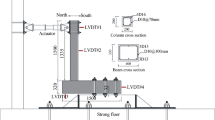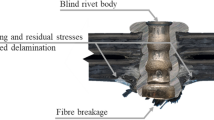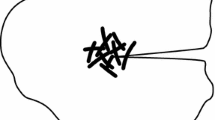Abstract
The maximum pull-out strength of bonded-in rods was used for investigating the relationship between the joint geometry and the rheology of the structural adhesive. Tests with a brittle and a ductile glue type, both formulated with epoxy resins, showed that the glue rheology has a strong influence on the joint behaviour. The joint thickness is also an important parameter, having a good correlation with pull-out strength and with the fracture typology. Wood density and moisture content had a very low influence on strength, in these test conditions. A modification of the Eurocode 5 equation was developed, allowing an improved use of the adhesive properties for a safer design. Results suggest that a standardised test method for bonded-in rods would be very helpful for the determination of basic joint properties such as the maximum joint thickness and the glue strength parameter that were used in the modified design equation.
Zusammenfassung
Die maximale Ausziehfestigkeit von verklebten Stäben wurde verwendet, um die Beziehung zwischen der Verbindungsgeometrie und der Rheologie von Bauholzklebern zu untersuchen. Tests mit einem spröden und einem duktilen Klebertyp, beide aus Epoxidharz gebildet, zeigten, dass die Kleber-Rheologie einen starken Einfluss auf das Fugenverhalten hat. Die Fugendicke ist ebenfalls ein wichtiger Parameter, der eine gute Korrelation zur Ausziehfestigkeit und mit dem Bruchbild hat. Holzdichte und Feuchtigkeit haben unter diesen Testbedingungen einen sehr geringen Einfluss auf die Festigkeit. Eine Modifikation der Eurocode 5-Gleichung wurde entwickelt, die eine verbesserte Anwendung der Klebereigenschaften für eine sicherere Konstruktion erlaubt. Ergebnisse lassen darauf schließen, dass eine standardisierte Testmethode für Leimbinder sehr hilfreich für die Bestimmung von Grundverbindungseigenschaften wäre, wie beispielsweise die maximale Fugendicke und der Kleberfestigkeits-Parameter, die beide in der modifizierten Konstruktionsgleichung verwendet wurden.







Similar content being viewed by others
References
ASTM D 638 (1999) Standard Test Method for Tensile Properties of Plastics
Avent RR (1992) Structural design for epoxy repair of timber. Wood design Focus 3/1992
Bengtsson C et al. (2000) Production control methods for glued-in rods for timber structures. Proceedings World Conference on Timber Engineering—Whistler, Canada
Ceccotti A, Marradi (1993) Nuove tecnologie negli interventi di recupero delle antiche capriate di legno: materiali e metodi. Il recupero degli edifici antichi (manualistica e nuove tecnologie). Atti del Convegno Internazionale, Napoli 29–30 Ottobre 1993
Deng, Moss, Buchanan (1998) Glued bolts in glulam—an analysis of stress distribution. Proceedings 5 th World Conference on Timber Engineering—Lausanne
EN ISO 10365:1995 - Adhesives. Designation of main failure patterns
ENV 1995–2:1997 - Eurocode 5:Design of timber structures—Part 2: Bridges
Guan ZW (1998) Structural behavior of glued bolt joints. Proceedings 5 th World Conference on Timber Engineering—Lausanne
Gustafsson PJ, Serrano E, Aicher S, Johansson CJ (2001) A strength design equation for glued-in rods. Proceedings, Joints in Timber Structures, 55 th RILEM Annual Week, Stuttgart, Germany
Harvey K, Ansell M (2000) Improved timber connections using bonded-in GFRP rods. Proceedings World Conference on Timber Engineering—Whistler, Canada
Jensen JL et al. (2001) Axially loaded glued-in hardwood dowels. Wood Sci Technol 35:73–83
Lavisci P et al. (2001a) A shear test for structural adhesives used in the consolidation of old timber. Holz Roh- Werkstoff 59:145–152
Lavisci P et al. (2001b) A delamination test for structural wood adhesives used in thick joints. Holz Roh- Werkstoff 59:153–154
Mettem CJ et al. (2000) Testing epoxy adhesives for the consolidation of old timber structures. CICOP 5th International Congress on Restoration of Architectural Heritage—Firenze, Italy
Phillips MW, Selwin JE (1978) Epoxies for wood repairs in historic buildings. Publication, Heritage Conservation and Recretation Service, US Dept. of the Interior, n 1
Ranta-Maunus A, Kangas J (1994) Glued-in Steel Rods in V-shape. Pacific Timber Engineering Conference, Gold Coast Australia
Riberholt H (1988) Glued bolts in glulam. Part 2. Series R, N° 228, Department of Structural Engineering Technical University of Denmark
Serrano E (2000) Glued-in rods for timber structures; a 3D model and finite element parameter studies. Int J Adhesion & Adhesives 21:115–127
Townsend PK (1990) Steel Dowels Adhesive Bonded in Glue Laminated Timber. Research Report 90/11, Department of Civil Engineering University of Canterbury, Christchurch, New Zealand
Author information
Authors and Affiliations
Corresponding author
Rights and permissions
About this article
Cite this article
Feligioni, L., Lavisci, P., Duchanois, G. et al. Influence of glue rheology and joint thickness on the strength of bonded-in rods. Holz Roh Werkst 61, 281–287 (2003). https://doi.org/10.1007/s00107-003-0387-4
Published:
Issue Date:
DOI: https://doi.org/10.1007/s00107-003-0387-4




